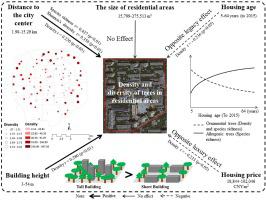Ecological Indicators ( IF 6.9 ) Pub Date : 2021-02-17 , DOI: 10.1016/j.ecolind.2021.107462 Min Jiao , Haoran Xue , Jingli Yan , Zhong Zheng , Jia Wang , Cheng Zhao , Lu Zhang , Weiqi Zhou

|
Urban trees provide a range of ecological services for urban dwellers. This is particularly true in residential areas where these services are known and valued. The abundance and diversity of trees determine and indicate the provision of ecological services by trees, while various characteristics of residential areas determine and indicate the abundance and diversity of trees within those areas. Exploring the abundance and diversity of trees in residential areas and their major driving and indicative factors is important for evaluating, predicting, and thus improving the ecological services provided by trees. Here, we selected 87 residential areas in Beijing through spatially stratified random sampling. Unlike the quadrat survey that is usually used, we conducted a detailed investigation of the abundance and diversity of trees in residential areas through a tree-by-tree survey and explored the major driving and indicative factors of the abundance and diversity of the trees. In the 87 sampled residential areas, 69 tree taxa belonging to 34 families were identified, and we found that the 10 most common species accounted for 55.9% of all trees. Trees in the residential areas had both high allergenic risk and high ornamental value. In newly built residential areas, the allergenic risk decreased but the ornamental value remained high. Average building height and distance to the city center were the two major driving and indicative factors of residential tree abundance, both of which were positive indicators, and the former played a larger role than that of the latter. In this study, distance to the city center was the only predicator of tree species diversity, and was also a positive indicator. The size of residential area did not show any relationship with tree abundance or diversity. Even though housing age and housing price were not included in the forecasting model, both showed a negative correlation with tree abundance, i.e., an opposite legacy effect and luxury effect. The results of this study can help in understanding tree abundance and diversity and their driving and indicative factors in residential areas in highly urbanized cities and can provide potential guidance for future residential tree planning and management.



























 京公网安备 11010802027423号
京公网安备 11010802027423号